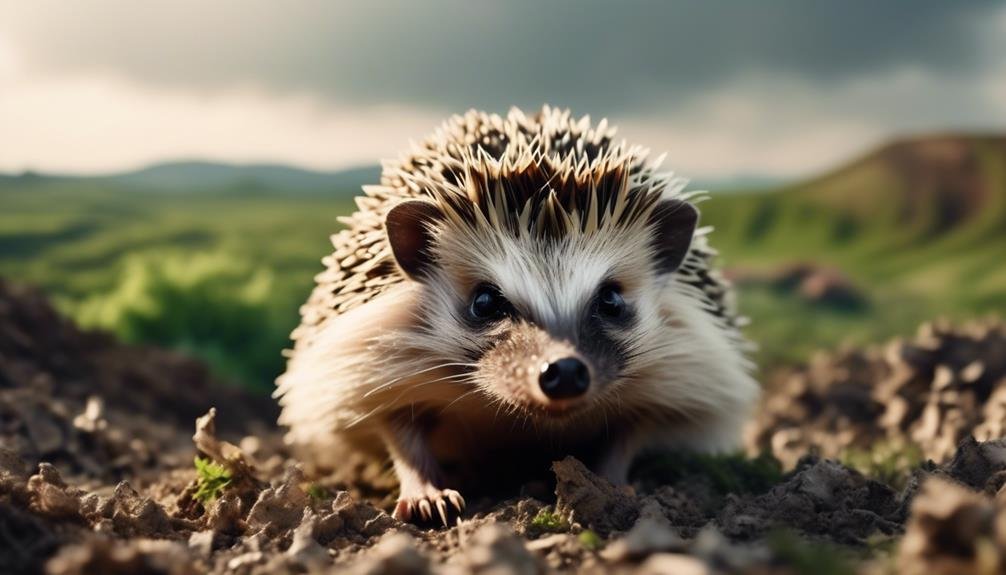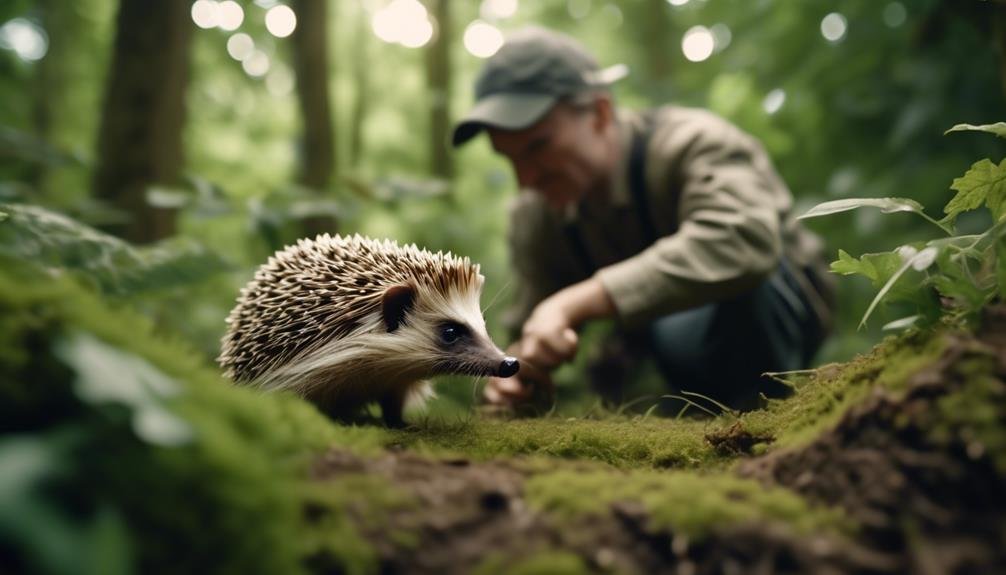
The European hedgehog, a beloved and iconic species, is facing a challenging predicament as its population dwindles due to the combined pressures of predators and habitat loss.
In particular, predation by badgers has emerged as a significant threat to hedgehog numbers, especially in the United Kingdom. Additionally, the loss and fragmentation of suitable habitats, coupled with the use of pesticides, have further compounded the challenges faced by these endearing creatures.
However, amidst these concerning circumstances, there is hope. Conservation organizations and individuals are actively promoting hedgehog-friendly practices and implementing innovative strategies to mitigate the detrimental impacts of these threats.
In this discussion, we will explore the specific challenges faced by European hedgehogs, delve into the role of predators and habitat loss in their declining population, and examine the various conservation efforts being made to safeguard their future.
Key Takeaways
- The European hedgehog population is declining, particularly in Britain, due to factors such as predators and habitat loss.
- Badgers are a significant predator of hedgehogs in the UK and may contribute to their declining numbers.
- Habitat loss and fragmentation, as well as the use of pesticides, are threats to hedgehog populations.
- Conservation efforts, such as promoting hedgehog-friendly practices and creating hedgehog highways, are important for protecting and preserving hedgehog populations.
Overview of Hedgehog Decline
The European hedgehog population has experienced a significant decline, with various factors such as predators, habitat loss, and human activities contributing to this alarming trend.
Predators, such as badgers, are the main threat to hedgehogs in the UK, as they prey on them and contribute to their declining numbers.
Habitat loss and fragmentation also pose a significant challenge to hedgehog survival. Urban development and the destruction of hedgerows, woodlands, and grasslands reduce the available habitat for hedgehogs to live and forage.
Additionally, human activities such as the use of pesticides and the increasing presence of roads result in higher mortality rates for hedgehogs.
These factors have led to a steady decline in the hedgehog population, both in rural and urban areas.
It is crucial to address these issues and implement conservation strategies to protect the European hedgehog and prevent further population decline.
Impact of Predators on Hedgehog Population
The presence of predators, particularly badgers, poses a significant threat to the declining European hedgehog population, exacerbating the challenges they face due to habitat loss and human activities. Badgers are known to prey on hedgehogs, leading to a decline in their numbers.
Here are five key impacts of predators on hedgehog population:
- Badgers are the main predator of hedgehogs in the UK, contributing to their declining numbers.
- Hedgehogs have a low reproductive rate, and predation by badgers further reduces their ability to recover.
- Predation by badgers can disrupt hedgehog populations in both rural and urban areas.
- Habitat fragmentation caused by human activities can increase the vulnerability of hedgehogs to predation.
- Conservation efforts must address the issue of predation by badgers in order to effectively protect hedgehog populations.
Habitat Loss and Its Effect on Hedgehogs

Hedgehogs are significantly impacted by habitat loss, which poses a major threat to their population. As human activities continue to encroach upon natural habitats, hedgehogs are losing their homes and vital resources. Urbanization, land development, and agricultural practices contribute to the destruction and fragmentation of their habitats.
The loss of suitable nesting sites, such as hedgerows, woodlands, and meadows, reduces the availability of safe and secure areas for hedgehogs to breed, hibernate, and forage for food. Additionally, the use of pesticides in agricultural areas can directly harm hedgehogs and reduce their prey base. Without suitable habitats, hedgehogs face increased vulnerability to predation, starvation, and other environmental pressures.
Conservation efforts to preserve and restore hedgehog habitats are crucial for their long-term survival.
Decline in Hedgehog Numbers in Britain
The alarming decline in the population of hedgehogs in Britain is a growing concern for conservationists and wildlife enthusiasts alike. The hedgehog, once a common sight in British gardens and countryside, is now facing a significant decline in numbers.
Several factors contribute to this decline, including:
- Habitat loss: The destruction and fragmentation of natural habitats, such as hedgerows and meadows, have significantly reduced suitable environments for hedgehogs.
- Predators: Badgers, a natural predator of hedgehogs, have increased in numbers and pose a significant threat to hedgehog populations.
- Road mortality: The high number of road casualties is another factor contributing to the decline of hedgehog numbers.
- Pesticide use: The use of pesticides in gardens and agricultural fields can have detrimental effects on hedgehogs and their food sources.
- Urbanization: The expansion of urban areas and the loss of green spaces have limited the available habitat for hedgehogs.
These factors combined have resulted in a steady decline in the hedgehog population in Britain, prompting conservation organizations and individuals to take action to protect and preserve this iconic species.
Conservation Efforts for Hedgehog Protection

To address the declining population of hedgehogs in Britain, significant conservation efforts have been implemented to protect and preserve this iconic species. Conservation organizations and individuals have been advocating for hedgehog-friendly practices, such as providing access to gardens, avoiding pesticide use, and creating hedgehog highways. Additionally, the European hedgehog is protected by law in some countries, including the UK and Poland. Research and monitoring projects are underway to assess population trends and develop effective conservation strategies. The table below highlights some of the key conservation efforts being undertaken to protect hedgehogs:
| Conservation Efforts |
|---|
| Providing access to gardens |
| Avoiding pesticide use |
| Creating hedgehog highways |
| Protected by law in the UK and Poland |
| Research and monitoring projects |
These efforts aim to mitigate the threats posed by habitat loss, fragmentation, road mortality, and the use of pesticides, which have contributed to the decline in hedgehog numbers. By implementing these conservation measures, there is hope to reverse the negative trends and ensure the long-term survival of hedgehog populations.
Threats to Hedgehog Survival
As efforts are being made to protect and preserve hedgehog populations through conservation initiatives, it is crucial to understand the various threats that pose a risk to their survival. These threats include:
- Predators: Badgers are the main predator of hedgehogs in the UK, contributing to their declining numbers. Hedgehogs are also preyed upon by foxes and domestic dogs and cats.
- Habitat Loss: Urbanization and agricultural practices have led to the destruction and fragmentation of hedgehog habitats. Loss of hedgerows, woodland areas, and meadows reduces the availability of suitable foraging and nesting sites.
- Road Mortality: Hedgehogs are frequently killed on roads, especially at night when they are most active. Increased traffic and the lack of suitable crossing points contribute to their vulnerability to road mortality.
- Pesticide Use: The use of pesticides in farming and gardening can have detrimental effects on hedgehogs. Ingesting poisoned prey or directly coming into contact with pesticides can lead to illness and death.
- Climate Change: Changes in climate patterns can affect hedgehog populations by altering their food availability, hibernation patterns, and reproductive success.
Understanding and addressing these threats is essential for the long-term survival of hedgehog populations and requires a combination of conservation efforts, public awareness, and policy changes.
Role of Human Activities in Hedgehog Decline

Human activities have played a significant role in the decline of hedgehog populations. One of the main factors contributing to this decline is habitat loss. As human populations expand and urban areas expand, natural habitats are being destroyed or fragmented, leaving hedgehogs with less suitable places to live and forage for food.
Additionally, the use of pesticides in agriculture and gardens poses a threat to hedgehogs. These chemicals can contaminate the hedgehogs’ food sources, leading to poisoning and a decline in their population.
Furthermore, human activities such as the construction of roads and buildings increase the risk of hedgehogs being hit by vehicles or trapped in urban areas, resulting in higher mortality rates.
It is crucial for humans to recognize the impact of their activities on hedgehog populations and take action to protect their habitats and minimize harm.
Research and Monitoring for Hedgehog Conservation
The importance of research and monitoring becomes evident in addressing the decline of hedgehog populations and developing effective conservation strategies. Research and monitoring for hedgehog conservation involves studying various aspects of their ecology, behavior, and habitat to gain a better understanding of their population dynamics and the factors affecting their survival. This information is crucial in formulating targeted conservation measures to mitigate the threats they face.
Here are five key aspects of research and monitoring for hedgehog conservation:
- Population surveys: Conducting surveys to estimate hedgehog population size, distribution, and trends over time.
- Habitat assessment: Assessing the quality and availability of suitable habitats for hedgehogs, including the impact of habitat loss and fragmentation.
- Predation studies: Investigating the role of predators, such as badgers, in hedgehog decline and exploring potential predator-prey dynamics.
- Health monitoring: Monitoring hedgehog health, including the prevalence of diseases and parasites, to identify potential threats and inform disease management strategies.
- Citizen science initiatives: Engaging the public in data collection through citizen science projects to gather information on hedgehog sightings, road casualties, and other relevant observations.
Through ongoing research and monitoring efforts, conservationists can gather essential data to inform evidence-based conservation actions and help ensure the long-term survival of hedgehog populations.
Frequently Asked Questions
What Is the Average Weight of a European Hedgehog at Adulthood?
The average weight of a European hedgehog at adulthood is approximately 1100g (40oz). This species, currently classified as Least Concern by the IUCN, faces threats such as habitat loss and predation. Conservation efforts aim to protect and monitor their population.
Do Blonde Hedgehogs Have a Different Physical Appearance Than Brown Hedgehogs?
Blonde hedgehogs have a different physical appearance than brown hedgehogs. They have creamy-colored spines and black eyes, but they are not albino. Blonde hedgehogs are rare, except on North Ronaldsay and Alderney.
How Long Does the Gestation Period Last for European Hedgehogs?
The gestation period for European hedgehogs lasts between 31 to 35 days. During this time, the female carries the developing young before giving birth to a litter of typically four to six blind and spiny offspring.
What Is the Primary Diet of European Hedgehogs?
The primary diet of European hedgehogs consists of earthworms, snails, slugs, beetles, ants, bees, wasps, and other insects. They may also eat the eggs of ground-nesting birds and forage on carcasses.
What Is the Main Predator of Hedgehogs in the Uk?
The main predator of hedgehogs in the UK is the badger. Badgers are known to prey on hedgehogs and may contribute to the declining population of hedgehogs in the country.
How can we protect hedgehog populations from predators and habitat loss in both European and desert environments?
Protecting the elusive desert hedgehog wanderer in both European and desert environments requires careful conservation efforts. Creating designated protected habitats, implementing predator control measures, and raising awareness about the importance of hedgehog conservation are crucial in preserving their populations. Collaboration between conservationists, local communities, and governments is essential for their survival.
Conclusion
In conclusion, the declining hedgehog population is facing significant threats from predators, particularly badgers, and habitat loss. These factors have led to a decline in hedgehog numbers, particularly in the United Kingdom.
Conservation efforts, such as creating hedgehog-friendly habitats and monitoring population trends, are being implemented to safeguard the future of this species.
It is crucial for individuals and organizations to actively participate in protecting hedgehogs and mitigating the detrimental impacts of these threats to ensure their survival.




